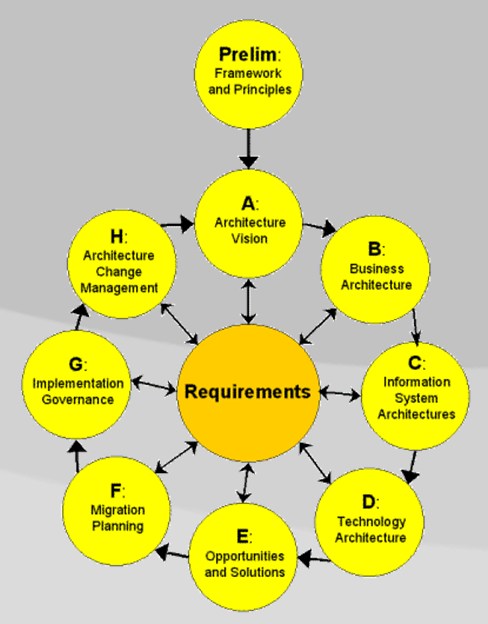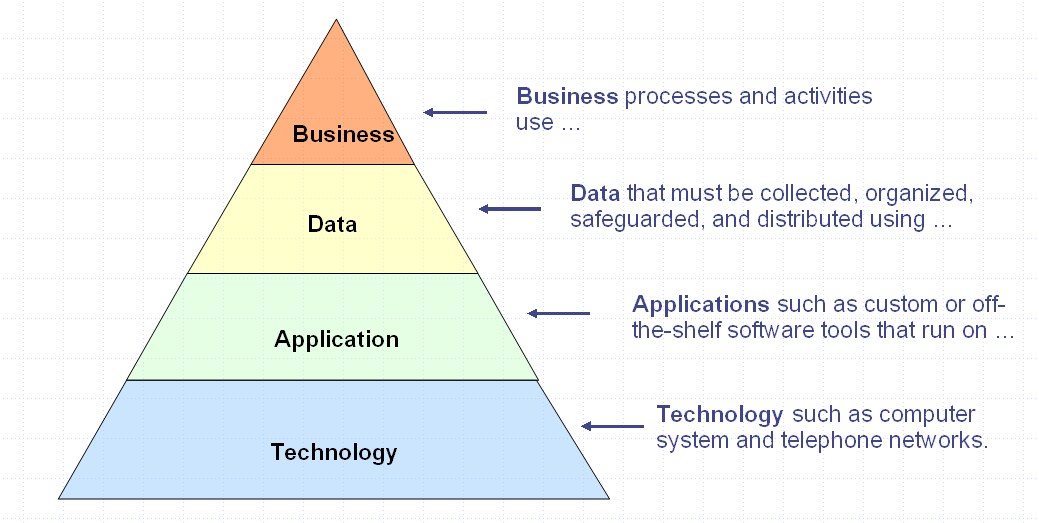|
Open Group Architecture Framework
The Open Group Architecture Framework (TOGAF) is the most used Enterprise Architecture framework, framework for enterprise architecture as of 2020 that provides an approach for designing, planning, implementing, and governing an enterprise information technology architecture. TOGAF is a high-level approach to design. It is typically modeled at four levels: Business, Application, Data, and Technology. It relies heavily on modularization, standardization, and already existing, proven technologies and products. TOGAF began to be developed in 1995 by The Open Group, based on the United States Department of Defense's TAFIM and Capgemini's Integrated Architecture Framework (IAF). As of 2016, The Open Group claims that TOGAF is employed by 80% of Dow Jones Global Titans 50, Global 50 companies and 60% of Fortune 500 companies. Overview An architecture framework is a set of tools that can be used for developing a broad range of different architectures. It should: * describe a method f ... [...More Info...] [...Related Items...] OR: [Wikipedia] [Google] [Baidu] [Amazon] |
Technical Architecture Framework For Information Management
Technical Architecture Framework for Information Management (TAFIM) was a 1990s reference model for enterprise architecture by and for the United States Department of Defense (DoD). TAFIM provided enterprise-level guidance for the evolution of the DoD Technical infrastructure. It identifies the services, standards, concepts, components, and configurations that can be used to guide the development of technical architectures that meet specific mission requirements.NHSITRC (2005)Consolidated References IT Planning and Management Guides, List of Resources. Last Updated: May 4, 2005. Accessed 12 Dec 2008. TAFIM has been developed by the United States Department of Defense from 1986 until 1999. Parallel in 1994 they started the development of the C4ISR Architecture Framework, which evolved into the Department of Defense Architecture Framework (DoDAF) in the new millennium. TAFIM concepts are further developed in TOGAF, which first version in 1995 was based on the TAFIM framework. Overv ... [...More Info...] [...Related Items...] OR: [Wikipedia] [Google] [Baidu] [Amazon] |
MEGA International Srl
Mega or MEGA may refer to: Science * mega-, a metric prefix denoting 106 * Mega (number), a certain very large integer in Steinhaus–Moser notation * "mega-" a prefix meaning "large" that is used in taxonomy * Gravity assist, for ''Moon-Earth gravity assist'' and ''Mars-Earth gravity assist'' Business * Aixam-Mega, a French automobile manufacturer based in Aix-les-Bains, Savoie * Megaupload, a file sharing site seized by the FBI * Mega (service), a cloud storage and file hosting service * Mega Aircompany, a charter airline based in Almaty, Kazakhstan * Mega Enterprise, a South Korean company that specialises in developing games * MEGA International Srl., a French software company * Mega Maldives, a Maldivian airline * MEGA, a Russian chain of supermarkets, until september 2023 owned by IKEA Music * ''Mega'' (Yacht album), 2005 * ''Mega'' (Blank Banshee album), 2016 * Mega Records, a US record label * Mega Records, former name of Danish record company Edel-Mega Rec ... [...More Info...] [...Related Items...] OR: [Wikipedia] [Google] [Baidu] [Amazon] |
BiZZdesign
Bizzdesign is a Dutch enterprise architecture and BPM SaaS platform vendor, founded in 2000 by Henry Franken, Harmen van den Berg and Harm Bakker, and is known for the co-development of ArchiMate and the development Bizzdesign Enterprise Studio, formerly BiZZdesign Architect, the first tool that supported ArchiMate. Inception Bizzdesign started as spin-off from a research project (1996-2001) to develop a test environment for business processes, originated by the Telematica Instituut (now Novay) in cooperation with partners such as the IBM, the Dutch Pension Fund APG, Tax and Customs Administration, and the ING Group. In 2016 the company presented the new variation of the software called Bizzdesign Enterprise studio In 2024 the software is still often listed in top-10 of Enterprise Architecture tools according to different reports See also * ArchiMate ArchiMate ( ) is an open and independent enterprise architecture modeling language to support the description, an ... [...More Info...] [...Related Items...] OR: [Wikipedia] [Google] [Baidu] [Amazon] |
Performance Engineering
Performance engineering encompasses the techniques applied during a systems development life cycle to ensure the non-functional requirements for performance (such as throughput, latency, or memory usage) will be met. It may be alternatively referred to as systems performance engineering within systems engineering, and software performance engineering or application performance engineering within software engineering. As the connection between application success and business success continues to gain recognition, particularly in the mobile space, application performance engineering has taken on a preventive and perfective"Banking Industry Lessons Learned in Outsourcing Testing Services," Gartner. August 2, 2012. role within the software development life cycle. As such, the term is typically used to describe the processes, people and technologies required to effectively test non-functional requirements, ensure adherence to service levels and optimize application performance prior ... [...More Info...] [...Related Items...] OR: [Wikipedia] [Google] [Baidu] [Amazon] |
Information Architecture
Information architecture (IA) is the structural design of shared information environments; the art and science of organizing and labelling websites, intranets, online communities and software to support usability and findability; and an emerging community of practice focused on bringing principles of design, architecture and information science to the digital landscape. Typically, it involves a model or concept of information that is used and applied to activities which require explicit details of complex information systems. These activities include library systems and database development. Definition ''Information architecture'' has somewhat different meanings in different branches of information systems or information technology: # The structural design of shared information environments. # The art and science of organizing and labeling web sites, intranets, online communities, and software to support findability and usability. # An emerging community of practice focused on ... [...More Info...] [...Related Items...] OR: [Wikipedia] [Google] [Baidu] [Amazon] |
Technical Architecture
Information technology (IT) architecture is the process of development of methodical information technology specifications, models and guidelines, using a variety of information technology notations, for example Unified Modeling Language (UML), within a coherent information technology architecture framework, following formal and informal information technology solution, enterprise, and infrastructure architecture processes. These processes have been developed in the past few decades in response to the requirement for a coherent, consistent approach to delivery of information technology capabilities. They have been developed by information technology product vendors and independent consultancies, such as for example the Open Group, based on real experiences in the information technology marketplace and collaboration amongst industry stakeholders. Best practice information technology architecture encourages the use of open technology standards and global technology interoperability. I ... [...More Info...] [...Related Items...] OR: [Wikipedia] [Google] [Baidu] [Amazon] |
Applications Architecture
In information systems, applications architecture or application architecture is one of several architecture domains that form the pillars of an enterprise architecture (EA). Scope An applications architecture describes the behavior of applications used in a business, focused on how they interact with each other and with users. It is focused on the data consumed and produced by applications rather than their internal structure. By example, in application portfolio management, applications are mapped to business functions and processes as well as costs, functional quality and technical quality in order to assess the value provided. The applications architecture is specified on the basis of business and functional requirements. This involves defining the interaction between application packages, databases, and middleware systems in terms of functional coverage. This helps identify any integration problems or gaps in functional coverage. A migration plan can then be dra ... [...More Info...] [...Related Items...] OR: [Wikipedia] [Google] [Baidu] [Amazon] |
Data Architecture
Data architecture consist of models, policies, rules, and standards that govern which data is collected and how it is stored, arranged, integrated, and put to use in data systems and in organizations. Data is usually one of several architecture domains that form the pillars of an enterprise architecture or solution architecture. Overview A data architecture aims to set data standards for all its data systems as a vision or a model of the eventual interactions between those data systems. Data integration, for example, should be dependent upon data architecture standards since data integration requires data interactions between two or more data systems. A data architecture, in part, describes the data structures used by a business and its computer applications software. Data architectures address data in storage, data in use, and data in motion; descriptions of data stores, data groups, and data items; and mappings of those data artifacts to data qualities, applications, locat ... [...More Info...] [...Related Items...] OR: [Wikipedia] [Google] [Baidu] [Amazon] |
Business Architecture
In the business sector, business architecture is a discipline that "represents holistic, multidimensional business views of: capabilities, end-to-end value delivery, information, and organizational structure; and the relationships among these business views and strategies, products, policies, initiatives, and stakeholders." In application, business architecture provides a bridge between an enterprise business model and enterprise strategy on one side, and the business functionality of the enterprise on the other side. It often enables the Strategy to Execution methodology. People who develop and maintain business architecture are known as business architects. Overview The term "business architecture" is often used to mean an architectural description of an enterprise or a business unit, an architectural model, or the profession itself. The Business Architecture Working Group of the Object Management Group (OMG) (2010) describes it as "a blueprint of the enterprise t ... [...More Info...] [...Related Items...] OR: [Wikipedia] [Google] [Baidu] [Amazon] |
Architecture Domain
An architecture domain in enterprise architecture is a broad view of an enterprise or system. It is a partial representation of a whole system that addresses several concerns of several stakeholders. It is a description that hides other views or facets of the system described. Business, data, application and technology architectures are recognized as the core domains in the most of proposed concepts concerned with the definition of enterprise architecture. Overview Since Stephen Spewak's book called enterprise architecture planning (EAP) in 1993, and perhaps before then, it has been normal to recognise four types of architecture domain. The British Computer Society's "Reference Model for Enterprise and Solution Architecture" also follows this subdivision but additionally mentions the (single) application architecture level just below the application''s'' architecture as well as the domains of information architecture, information systems architecture, or security architect ... [...More Info...] [...Related Items...] OR: [Wikipedia] [Google] [Baidu] [Amazon] |


